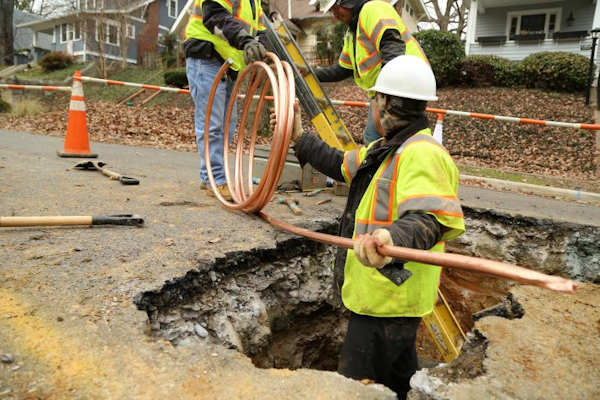SEJournal Online is the digital news magazine of the Society of Environmental Journalists. Learn more about SEJournal Online, including submission, subscription and advertising information.
 |
 |
| Workers in Washington, D.C., replacing lead service lines. The U.S. Environmental Protection Agency estimates the U.S. has 6 million to 10 million such lines underground. Photo: DC Water. |
TipSheet: Funding To Replace Lead Pipes Is Just the Start of the Story
By Joseph A. Davis
Looking for local and regional environmental stories in 2024? The lead pipe problem may be right under your feet and, if so, could keep you very busy.
 |
When Congress and President Biden agreed to set aside $15 billion over five years to rid the nation of millions of lead service lines, it did not solve the problem. Somebody still has to find, dig up and replace the unsafe pipes.
And while the situation varies widely from place to place, your community may be drinking that water right now. Journalists will do their audiences a favor by bird-dogging that funding and those fixes.
One team showing how it’s done in recent weeks was led by Associated Press reporter Michael Phillis, with a package on lead pipe replacement. While AP’s ace data journalism here may be hard to replicate, its groundbreaking may make coverage easier for other reporters.
The news was not good.
Pipes are not yet being replaced
as often or as fast as they could.
The news was not good. Pipes are not yet being replaced as often or as fast as they could. The key mystery in the AP reporting was that some states are declining to ask for and spend available federal money for lead service line replacement efforts. Explanations so far are less than illuminating.
Why it matters
Lead in any amount is toxic to humans. Children are much more vulnerable, if they are exposed as they grow up.
Lead poisoning in children can cause learning and behavior problems, lower IQ and hyperactivity, slowed growth, hearing problems and anemia, according to the U.S. Environmental Protection Agency.
Lead poisoning in pregnant women can cause the baby to be born too early or too small; hurt the baby’s brain, kidneys and nervous system; increase the likelihood of learning or behavioral problems; and put the mother at risk for miscarriage.
Remember Flint, Michigan? The 2014 water crisis there put the lead pipe issue on the map, not only as a public health, water chemistry and political corruption issue but also as an environmental justice issue.
The distortions of the mediasphere helped many people believe that lead pipes are mostly a problem in Flint. Nope. The fact is that lead service lines are a (possibly worse) problem in many places across the country (you can find more context with early reporting on the problem from CNN and USA TODAY).
Multiple sources, difficult to test
It’s good to remember that lead pipes are not necessarily the biggest source of lead poisoning. Lead paint, occupational exposure, dirt and dust, smelting emissions and even food, crockery and folk remedies can be important sources.
Assessing the problem in your community depends a lot on testing. That turns out to be hard — harder for lead than for many other contaminants.
Lab technicians at the treatment plant can’t really do it, because the lead gets into the water after it leaves the plant. Plant technicians need instead to test the corrosivity of the water — its ability to leach lead out of the pipes.
Somebody has to test the water,
following very specific protocols,
as it comes from the tap.
But somebody has to test the water, following very specific protocols, as it comes from the tap.
The other kind of assessment that’s important is testing kids’ blood lead levels, because that’s where the damage is done. Many pediatricians do it routinely, but not all kids even see doctors regularly.
Reporters should know that the Centers for Disease Control collects and publishes testing information, which may help identify problems where you are.
The backstory
Lead poisoning is a very old problem — because human use of lead is also ancient. Whether or not it is true, some say the fall of ancient Rome was hastened by the effects of lead on its citizens.
The problem of lead poisoning in humans was identified as long ago as the second century B.C. Certainly the Industrial Revolution brought more exposure. Understanding grew as science advanced. But denial has been almost as strong as science.
The main threat now is all that lead paint and piping that was installed decades ago — and is still in place and in use. Lead paint and lead pipes were in common use well into the 20th century. Lead paint was only outlawed at the federal level in 1978. And it wasn’t until 1986 that Congress banned the use of lead in plumbing (a struggle still going on today).
The most common place you will find lead pipe in the United States is in those “service lines” which connect the (usually cast iron) water mains to each individual house or building in an area. The EPA estimates that there are still some 6 million to 10 million lead service lines underground in the United States.
Congress mandated EPA to require most major drinking water utilities to assess and locate, as well as possible, the lead service lines in their customer area. It’s called a Lead Service Line Inventory, and utilities must complete it by January 2024 — and make it available to the public.
Good news for journalists is that it will be
comparatively easy to identify money
being spent in your jurisdiction.
Another piece of good news for journalists is that it will be comparatively easy to identify money being spent in your jurisdiction on lead service line inventory and replacement.
Instead of using a national tracking system, you can track it through the EPA. The agency will distribute most of the money through either the Drinking Water State Revolving Fund or the Water Infrastructure Finance and Innovation Act fund. Start tracking it here.
Story ideas
- Ask your local drinking water utility whether it has completed the required lead service line inventory. If so, get a copy.
- What’s the lead-in-water situation at your local schools? Are the water fountains working? Cooling devices and tanks in these fountains often contain lead.
- What sort of funding is available in your community for lead pipe replacement? Do locals have to pay a share?
- What sort of testing has been done of lead contamination in water at the tap in your community? What were the results? What action, if any, followed?
- Talk to local pediatricians and public health departments. Ask how much lead blood level testing is done for children in your community. What have the findings been?
- Find out more about the history of public water supply in your area. Many systems have been built up in layers over the decades with urban expansion. What does this tell you about where the lead pipes are?
- Talk to local water utilities about whether and how much they test pH and other indicators of water corrosivity.
- Talk to your state drinking water agency about their plans for using available funds for lead pipe inventory and replacement.
- Is your community one where part of the responsibility for (possibly lead) service lines falls on the utility and part on the homeowner? How is this resolved?
Reporting resources
- U.S Environmental Protection Agency: The EPA is responsible for overseeing state regulation of drinking water systems. The agency also oversees the Drinking Water State Revolving Fund, the primary vehicle for federally funding lead pipe replacement.
- Local drinking water utilities: If you don’t know who provides your local drinking water, start here.
- State drinking water agencies: Agency names vary by state. If you don’t know yours, start here.
- Association of Metropolitan Water Agencies: AMWA is a professional and lobbying group representing the bigger city water systems.
- American Water Works Association: A professional and lobbying group representing drinking water utilities.
- Natural Resources Defense Council: The NRDC is a litigation-focused environmental group that has long specialized in drinking water issues.
- Centers for Disease Control: The CDC is the main U.S. public health agency, with a special interest in lead poisoning. It compiles statistics on lead poisoning.
[Editor’s Note: SEJournal has published numerous stories in recent years about the lead poisoning problem, including TipSheets on lead pipes, the challenge of tracing lead lines and congressional infrastructure plans, along with Backgrounders on environmental justice and the widespread problem of lead in the water supply, and on a nationwide investigative report. On the Flint crisis, SEJournal also offered an analysis on its lessons, and interviewed the physician instrumental in exposing the crisis, as well as reviewed her book, along with an earlier volume on the “Lead Wars.” On lead paint, there are TipSheets on paint toxicity and health risks, as well as an Inside Story Q&A with an award-winning team reporting on lead paint in Philadelphia’s schools. For recent headlines, search EJToday for lead in water, lead pipes and lead paint.]
Joseph A. Davis is a freelance writer/editor in Washington, D.C. who has been writing about the environment since 1976. He writes SEJournal Online's TipSheet, Reporter's Toolbox and Issue Backgrounder, and curates SEJ's weekday news headlines service EJToday and @EJTodayNews. Davis also directs SEJ's Freedom of Information Project and writes the WatchDog opinion column.
* From the weekly news magazine SEJournal Online, Vol. 8, No. 34. Content from each new issue of SEJournal Online is available to the public via the SEJournal Online main page. Subscribe to the e-newsletter here. And see past issues of the SEJournal archived here.












 Advertisement
Advertisement 



